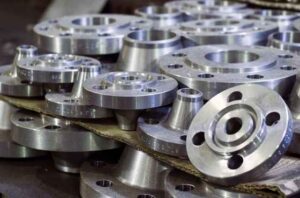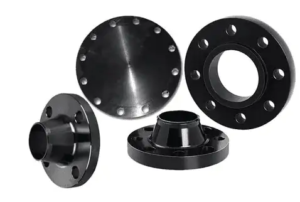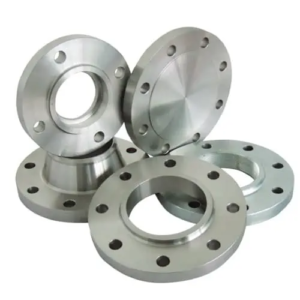When it comes to industrial applications, the choice between carbon steel and stainless steel can be a significant decision. Understanding the differences between these materials is essential to ensure that your project is on the right track. This article aims to provide a detailed comparison of these two materials, covering their composition, properties, and practical applications.
Image Source: Texas Flange
Steel Basics:
Steel is a unique alloy that blends iron with one or more other metals. In the case of carbon steel and stainless steel, their composition sets them apart.
Carbon Steel
Carbon steel is the most basic form of steel, consisting primarily of iron and carbon. It may also contain small amounts of other elements. Carbon steel is categorized based on its carbon content, with low-to-mid carbon steel containing less than 0.3% carbon and high carbon steel containing up to 2% carbon. Carbon steel is known for its strength and its ability to withstand high temperatures.
Image Source: Texas Flange
Stainless Steel
Stainless steel, on the other hand, includes a minimum of 10% chromium in its composition. This gives it remarkable resistance to rust and corrosion. While it may also contain other elements, stainless steel’s standout feature is its ability to resist rust—a unique property in the world of steel.
Image Source: Texas Flange
Carbon Steel vs. Stainless Steel
Corrosion Resistance
One of the most significant differences between these two materials is their resistance to corrosion. Stainless steel has excellent corrosion resistance, making it ideal for harsh environments with moisture, acids, and contaminants. Carbon steel, on the other hand, is more prone to corrosion, especially in environments with high moisture or acidity.
Cost
Cost is another key factor when deciding between these materials. Stainless steel is generally more expensive than carbon steel due to the cost of materials and manufacturing. However, the extra cost may be justified if your application demands stainless steel’s enhanced durability and corrosion resistance.
Strength and Durability
Both stainless steel and carbon steel are robust materials, each with unique characteristics. Stainless steel offers high strength and resistance to wear and tear, making it ideal for heavy-duty applications. Carbon steel is slightly less robust than stainless steel but remains durable under standard operating conditions.
Temperature Resistance
Temperature resistance is another factor to consider. Stainless steel can withstand higher temperatures than carbon steel, making it suitable for applications where elevated heat is a concern. Carbon steel is better suited for applications with less extreme temperature conditions.
Maintenance
Maintenance is a crucial consideration when selecting these materials. Stainless steel is generally easier to maintain than carbon steel because it’s less prone to corrosion and wear. Regular cleaning and preventive measures like painting or coating can maintain carbon steel and prevent corrosion.
Making the Right Choice
Choosing between carbon steel and stainless steel comes down to understanding their differences and evaluating your project’s specific needs. Both materials have their unique characteristics, strengths, and limitations. The right choice should align with your application’s requirements, such as temperature, pressure, and corrosion resistance. Collaborating with a trusted supplier is essential to ensure that you select the right material for your project, and it’s important to consider your budget and long-term maintenance plan.
FAQs (Frequently Asked Question):
- What is the primary difference between carbon steel and stainless steel?
- The key difference lies in their composition. Carbon steel contains a combination of iron and carbon, while stainless steel includes at least 10% chromium, providing corrosion resistance.
- Why is corrosion resistance important in steel selection?
- Corrosion resistance is essential in environments with moisture, acids, and contaminants. It ensures the material’s durability and longevity.
- Which is more affordable, carbon steel, or stainless steel?
- Generally, carbon steel is more cost-effective than stainless steel due to material and manufacturing cost differences.
- What applications benefit from the strength of stainless steel?
- Stainless steel’s high strength and resistance to wear and tear make it ideal for heavy-duty applications such as construction and aerospace.
- When should I choose carbon steel for my project?
- Carbon steel is suitable for applications with lower corrosion risk and where cost-efficiency is a primary consideration.
- Can stainless steel withstand extreme temperatures?
- Stainless steel has better temperature resistance, making it suitable for applications involving high heat. Carbon steel is better for less extreme temperature conditions.
- Are there different types of stainless steel alloys available for specific applications?
- Yes, various stainless steel alloys are tailored for specific needs, such as food-grade stainless steel, marine-grade stainless steel, and heat-resistant stainless steel.
- Is maintenance easier for stainless steel compared to carbon steel?
- Yes, stainless steel is generally easier to maintain because it’s less prone to corrosion. Regular cleaning and protective measures can ensure its longevity.
- Can I use carbon steel in high-moisture environments?
- Carbon steel can be used in such environments but may require more maintenance to prevent corrosion. Stainless steel is often a better choice for long-term durability.
- What factors should I consider when choosing between carbon steel and stainless steel for a piping system?
- You should consider factors such as the substance being transported, temperature requirements, budget constraints, and the need for corrosion resistance.
- Are there specific industry standards for these materials?
- Yes, there are industry standards and codes that specify the appropriate use of carbon steel and stainless steel in various applications, ensuring safety and performance.
- Can carbon steel and stainless steel be used interchangeably in a project?
- In some cases, they can be used interchangeably, but it depends on the specific requirements of the project, including environmental conditions and material compatibility.
- Which material is more eco-friendly, carbon steel, or stainless steel?
- Both materials have their environmental impacts, but stainless steel’s corrosion resistance can lead to a longer lifespan, potentially reducing the need for replacement and waste.
- Can I weld carbon steel and stainless steel together in a single system?
- Welding carbon steel and stainless steel together is possible, but it requires careful consideration of the materials’ compatibility and the specific welding process used.
- Are there specialized types of stainless steel or carbon steel for unique applications, like marine environments or extreme temperatures?
- Yes, specialized alloys of both carbon steel and stainless steel are available to address specific requirements. For instance, marine-grade stainless steel is tailored for maritime applications, while high-temperature carbon steel alloys are designed for extreme heat conditions.
Conclusion
In conclusion, the choice between carbon steel and stainless steel is pivotal for the success of your project. Understanding their properties and applications will help you make an informed decision and ensure the efficiency and reliability of your materials.
For more in-depth information, consider exploring the following resource:
https://www.texasflange.com/blog/stainless-steel-vs-carbon-steel-pipe-fittings/


